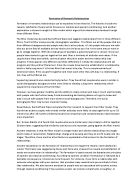Describe and evaluate two or more theories of the formation of romantic relationships
Describe and evaluate two or more theories of the formation of romantic relationships (24 marks)
One theory of how romantic relationships are formed comes from Kerckhoff and Davis’ filter model, which was introduced in 1962. The model proposes that relationships develop through three ‘filters’ and different factors are important at different times. According to this model, we start off with a ‘field of availables’ which are all the possible people we could have a relationship with, and then we filter out potential partners for different reasons at different times. So, the ‘field of availables’ soon becomes a ‘field of desirables’ and these are those people who we consider as potential partners.
The first of the filters involves the social/demographic variables and this is where we tend to pick people with similar educational and economical background to us. Once two people have started going out together, the next filter is the similarity of attitudes and values. This involves filtering out people with different beliefs, values and attitudes to us. The third filter is the complementarity of emotional needs, and this is where we decide how well people fit together as a couple and meet each other’s needs.
One strength of this model is that there is supporting evidence to back it up. Kerckhoff and Davis tested the model using a longitudinal study of students who had been together for more or less than 18 months. It was found that attitude similarity was an important factor up to about 18 months into a relationship. This supports the model because it suggests that similar attitudes and values may determine whether or not a couple stay together. However, having said that, the study only used students as participants. This is a problem because not all couples are students. What may be important to students may not be as important for other people. For example, whilst student may find it important that their partners to share similar attitudes as them, other people may find that the important thing to them is whether or not their partner can meet their needs. So, one cannot generalise the results of this study to the rest of the human population.
Another strength of this model is the fact that it provides an explanation of how relationships are formed, so this model could potentially help those people who have troubles starting a relationships. For example, they could use this model as guidance in order to choose the right type of people they could start a relationship with.
However, it could be argued that Kerckhoff and Davis’ model is rather deterministic. For example, it is deterministic in the sense that it suggests that people do not have a choice but to filter out those people with different attitudes and values to them. This is not always true as some people do have free will as to who they filter out. For example, they may choose to filter out those with similar attitudes and values to them and instead start a relationship with someone who is completely different to them. They may choose to start a relationship with someone who is different to them because they may want to learn new things that they didn’t know about, or maybe they may have fund it rather boring to date one type of person.
However, the idea that we filter out people who are not similar to us may be true to an extent. For example, it does make sense that a person, who loves socialising with people, is likely not to start a relationship with someone who hates socialising because communication may prove to be difficult and the relationship may not be enjoyable.









